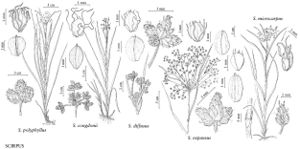Difference between revisions of "Scirpus microcarpus"
in C. B. Presl, Reliq. Haenk. 1: 195. 1828.
FNA>Volume Importer |
FNA>Volume Importer |
Revision as of 19:07, 24 September 2019
Plants spreading; rhizomes reddish, long, with conspicuous nodes and internodes. Culms: fertile ones upright or nearly so; nodes without axillary bulblets. Leaves 4–11 per culm; sheaths of proximal leaves red; proximal sheaths and blades with septa few to many, conspicuous or inconspicuous; blades 23–60(–75) cm × 5–15(–20) mm. Inflorescences terminal; rays divaricate or ascending, proximal branches almost smooth, distal branches scabrous, rays without axillary bulblets; bases of involucral bracts green, black, or red, not glutinous. Spikelets in dense clusters of (1–)3–18 (largest cluster with 6 or more spikelets), spikelets sessile, 2–8 × 1–3.5 mm, ovoid or narrowly ovoid; scales green or black, broadly ovate or ovate to broadly elliptic or elliptic, 1.1–3.4 mm, apex rounded to acute or apiculate or occasionally mucronate, apiculus or mucro (if present) to 0.2 mm. Flowers: perianth bristles persistent, (3–)4(–6) per flower, stout, straight or curved, shorter than to 1.5 times as long as achene, with retrorse, thick-walled, sharp-pointed teeth densely arranged almost to base, enclosed within (occasionally weakly projecting from) scales; styles 2(–3)-fid. Achenes almost white, ovate to obovate in outline, biconvex to plano-convex, 0.7–1.6 × 0.8–1 mm. 2n = 64, 66.
Phenology: Fruiting early summer (Jun–Jul).
Habitat: Marshes, moist meadows, ditches
Elevation: 0–2900 m
Distribution

St. Pierre and Miquelon, Alta., B.C., Man., N.B., Nfld. and Labr., N.W.T., N.S., Ont., P.E.I., Que., Sask., Yukon, Alaska, Ariz., Calif., Colo., Conn., Idaho, Ill., Ky., Maine, Mass., Mich., Minn., Mont., Nebr., Nev., N.H., N.J., N.Mex., N.Y., N.Dak., Oreg., Pa., R.I., S.Dak., Utah, Vt., Wash., W.Va., Wis., Wyo., Mexico (Baja California), e Asia (Kamchatka Peninsula).
Discussion
Scirpus microcarpus occasionally hybridizes with S. expansus, particularly in New England.
Populations of Scirpus microcarpus from eastern United States have been treated as a distinct species, S. rubrotinctus Fernald. Populations from the central part of the continent are intermediate for the characters Fernald used to separate S. rubrotinctus. The taxonomy of the group should be reinvestigated. Populations from the Queen Charlotte Islands (British Columbia) have a different chromosome number (2n = 64; R. L. Taylor and G. A. Mulligan 1968) than populations from New York and Pennsylvania (2n = 66; A. E. Schuyler 1967, 1976).
Selected References
None.
